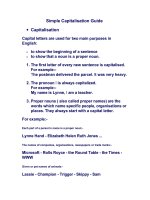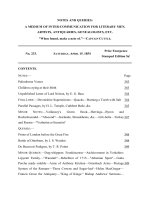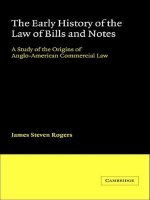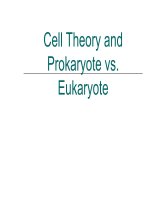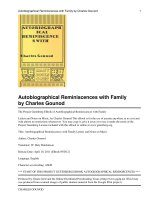- Trang chủ >>
- Đề thi >>
- THPT Quốc Gia
s2023 notes
Bạn đang xem bản rút gọn của tài liệu. Xem và tải ngay bản đầy đủ của tài liệu tại đây (256.21 KB, 6 trang )
STUDY NOTES
EPISODE 23: ECO-SYSTEMS
PRONUNCIATION CHANGES WHEN
LINKING CONSONANTS
English has combinations of sounds, which are
peculiar to English, and for many speakers of
other languages it is the clusters of consonants in
English, especially those at the ends of words,
which pose the greatest difficulty.
Linking final consonants to the beginning of the
following word makes speech sound more natural.
In rapid speech, however, sounds drop out, are
run together, or reduced in length.
Joining sounds in English
STUDY TIPS
It is critically important in the
IELTS Speaking test to speak
clearly and fluently to ensure
what you say is understood
without too much effort for the
examiner.
Understanding rhythm and stress
in English and what happens in
fluent speech as a result of these
features will help a speaker
become more confident and
competent when speaking.
Combinations of consonants in English either at
the beginning or the end of a word, and especially
when these involve the “th” sound, present
challenges to students who are learning to speak English.
To develop an awareness of the consonant + vowel (C+V), or consonant cluster (C+C+V)
aspect of the sound system of English, and to provide organized and systematic practice
combining sounds for all students of English, it is a good idea to progress by starting with a
vowel or combination of vowel sounds (diphthongs) and then add consonants either side.
Pronounce the groups of words in the following table and repeat one at a time across the
rows, building up and adding consonants as you go. Make sure you pronounce consonant
groups and clusters clearly and smoothly.
V
V
CV/VC
CVC
CCV/CCVC
CVCC
CCVCC
/ /
Ugh?
huh?
us
hut
tub
fuss
stub
shuts
tubs
fussed
stubbed
tar
art
tart
star
tarts
starts
Len
glen
lend
blend
worm
turn
learn
stir/stirs
slur/slurs
turns
learnt
sterns
slurps
ill
sill
will
still
swill
silks
wilt
stilts
quilts
me
meet/meat
reed
beam
she’ll
are
/ /
err
/ /
E
were
bee
she
eat
tree
meets
trees
beams
shield
streets
shields
Page 1 of 6
V
V
CV/VC
CVC
CCV/CCVC
CVCC
CCVCC
/ /
or
paw
ought
pores
spore/sport
ports
sports
air
where/wear
chair
aired
where’s
chairs
ear
near
nears
sneer
nears
I
rye
why
right
white
wine
lime
/
/ /
/
lie
I’m
/
A
Eh?
say
way/weigh
ray
ache
aim
climb
sane
wane
rain/reign
rake
rate
take
wake
lame
stain
train
bray
great
steak
quake
blame
rites
Bright’s
wines
limes
climbs
Seine’s
Wayne’s
rains/reins
rakes
rates
takes
wakes
lames
stains
trains
brakes
grates
steaks
quakes
blamed
A. Linking sounds
When speaking we tend to join words together in a continuous stream of speech. It is
incorrect to separate and over-articulate every sound in every word. We need to
develop a feel for the rhythm or pulse of the English language.
End sounds of a word are linked to the initial (front or first) sound of the following
word in fluent speech. Joining sounds together is a feature of spoken language and
is essential if we want to sound fluent when we speak.
Joining final consonants to initial vowels will actually help you pronounce the final
consonant.
The familiar English nursery rhyme, “Pat-a-cake”, will help you understand how
linking operates in English. (NB: “Pat” means “tap” or “hit gently”).
Pat a cake, pat a cake, baker’s man.
Bake me a cake as fast as you can.
Pat it, and prick it and mark it with “T”.
Put it in the oven for Tommy and me.
There are different types of linking illustrated in this Nursery Rhyme:
1. C + V
join final consonant with initial vowel
pat a
cake as
fast as
∪
∪
∪
pa-ta
ca-k-as
fas-tas
/pæ - t /
/ke - k z/
/fas - t z/
Page 2 of 6
2. C + C
final consonant and initial consonant
baker’s man
∪
baker – sman
/b k zmæn/
3. V + V
V j V
me a
me + /j/ + a
/mij /
the oven
the + /j/ + oven
/ðij v n /
Tommy and
Tommy + /j/ + and
/t mij nd/
Practise saying the rhyme as smoothly as possible – making all final
consonants clear by linking them to the initial sounds of the following words.
Pa t a cake. Pa t a cake, baker ’s man.
Bake m e a ca ke as fas t a s you can.
Pa t i t, and pri ck i t and mar k it with “T”.
Pu t i t in the oven for Tommy and me.
B. Linking V + V
There are further instances in English of the V + V type of linking. Above we have an
example of the insertion of the semi-vowel /j/ between vowels where the first vowel is
a member of the /i/ group - / /, /i/, /a /, /e /, and / /.
Some further examples of this effect are:
1. /j/
He and
he /j/ and
/hij nd/
S/He is
s/he /j/ is
/ ij z/
We are
we /j/ are
/wija/
Mary is
Mary /j/ is
/m rij z/
There is another sound, which appears or occurs following certain vowel
groups:
2. /w/
koala
ko /w/ ala
/k
wal /
cooperate
co /w/ operate
/k
w p re t/
/k
w ns d ns/
coincidence co /w/ incidence
Page 3 of 6
C. Linking C + C
Linking involving two consonants is straightforward when the two sounds involved
are already possible sound combinations in English. The example “baker’s man” from
the Nursery Rhyme is understandable because we have many words beginning with
“sm” in English – “small”, “smell”, “smile”, “smelt” and so on.
As seen above, there are several possible consonant combinations in English in initial
positions. They break down into basically C+ /l/, and C+ /r/, with the exception of
combinations with /s/ - /spl-/, /spr-/, /str-/ and /skr-/, which are of course CC+ /l/ and CC+
/r/:
+ /l/
play, plight, plain, plant
black, blind, blank, bleak,
blast
cling, clamp, clap, class,
climb
glass, glow, glove, globe
+ /r/
+/w/
prang, pray, preach, prawn
break, bring, breast, breath
crack, craft, crash, crawl
quick, quite, quiet
grass, grape, grow, ground
Gwendolen
train, tram, trend, trick, trim, try
twin, tweak, twenty, twitch
drink, drain, drive, drum, dry
flame, float, flood, flour,
floor
friend, frank, frame, fresh, from
throw, throat, throb, thrift, three
thwack
shrink, shriek, shrub, shred,
shrewd
slang, slip, slump, slant,
slide
splash, split, splice, spleen,
splendid, splint
swing, sweep, sweet,
swear, sweat
spray, spring, sprint, sprain,
spread
stray, straight, string, stretch,
stress, stream
screen, scrub, scratch, screw,
scribble, scrap
squeeze, squint, squash
In English, /s/ also combines with other sounds at the beginning of a word:
/sk-/ skin, scalp, scald, scare
/sm-/ small, smell, smile
/sn-/ snail, sneak, sniff
/sp-/ spend, spit, spare
As seen above, there are many more possible consonant combinations at the end of
words in English. However, the possible combinations are fixed for English. The
English language has established its own possible and acceptable combinations.
Page 4 of 6
Words, which have been introduced to English, can be easily and quickly discovered,
because they break the rules of these patterns.
In English it is not possible to have the initial consonant combination of /vl/. So the
name “Vlad” must be a foreign name. A word, “vroom” has been created, copying the
sound of a car engine starting up. This is the only word in English with the
combination /vl/ in initial position.
D. Linking C1 + C1 (both consonants are the same)
When the final consonant is identical with the following initial, there is no need to rearticulate or repeat the sound. It is only necessary to sustain it and carry it over onto
the next word.
What’s small, long and dry?
∪
∪
∪
I had a cough for a week.
∪
Did David do the work?
∪
∪
Come in November with Theo and Derek.
∪
∪
∪
However, when two consonants come together which are usually not found in
consonant clusters in the English language, then something has to be sacrificed.
Take for example “with ‘T’” from “Pat it and prick it and mark it with ‘T’”.
In English we do not have “th” preceding a /t/. This is not a possible consonant
combination in English. When speaking slowly it is possible to articulate “with” and
then “T” making sure all sounds are clear and distinct. In fluent speech at native
speaker speed, the final “th” would be approximated and would be blended into or
disappear into the following /t/ - /w ðti/.
Because the place of articulation for /th/ and /t/ is close (tongue and teeth), the
tongue easily glides from one position to the next.
For sounds which are quite distinct - /k/ and /f/ it will be noticed that they will be
articulated more clearly.
Example:
Ask Fred to join us.
∪
Make Phillip feel at home.
∪
E.
sound in English
Sometimes initial /h/ (and /h/ in a middle position) is pronounced in English, and
sometimes it isn’t. Usually /h/ is pronounced, but there are some words in English
where the /h/ is silent, or “unaspirated”.
Page 5 of 6
Unaspirated /h/
Aspirated /h/
honour, honest, dishonour, dishonest
hour
heir
vehicle
exhibit, exhibition, exhume, exhaust, exhilaration
hotel
happy, happen, hippy, Hepatitis,
hope, hype
hunger, hungry, Hungary
hand
In the table below, the sounds or words in the left column are repeated in the right
column but a new word or words are made when /h/ is added at the beginning in
initial position.
Practice saying the words in the column on the left, followed by the words in the right
column. When saying the words in the right column, be sure to pronounce the initial
/h/ sound.
For example: “and”, /ænd/ and “hand”, /hænd /; “air”, /
/ and “hair”, /h
No Initial /h/ sound
Initial /h/ sound
and, air
hand, hair
I, eye
high, height, hi
L
hell, hello, heaven
N
hen
M
hem
O
ho, hose, horse
8
hate
apt
happy, happen, hippie
eel
heel, he’ll
ill
hill
all
hall
ail
hail
allow
hallow
ache
Hake
old
hold, hole, holy, wholly, hollow
ounce
hounds
opt
hopped
or, oar, ore, awe, ought
hoar, horse, hoarse, haughty
/.
However, when we speak more quickly, sometimes the initial /h/ drops out, or is
elided. This is especially so when the word beginning with /h/ is unstressed.
The personal pronouns he, her, hers, his, him, and the auxiliary verbs have, has,
had are all usually unstressed. In fluent speech the initial /h/ is often dropped.
Page 6 of 6

